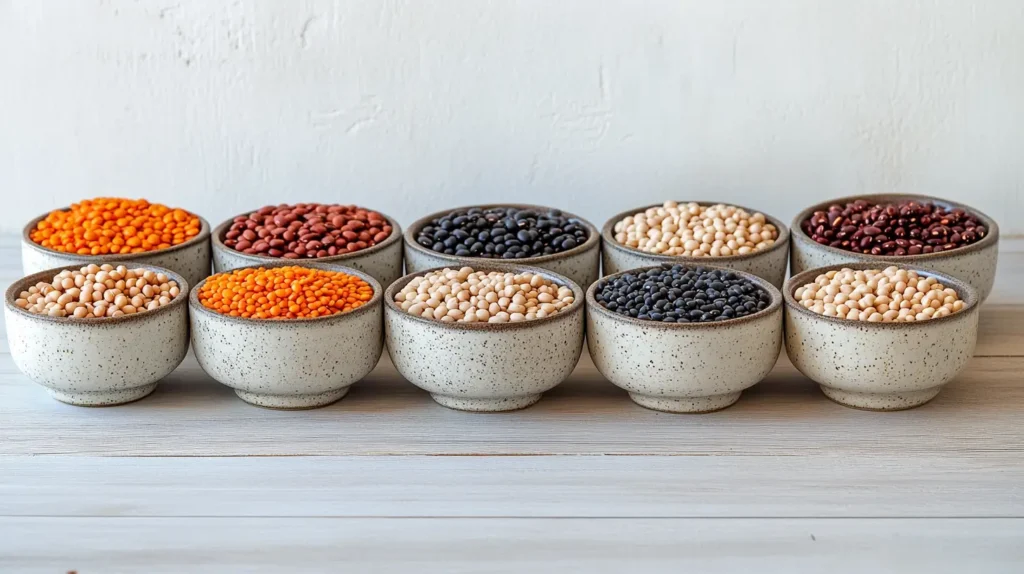Introduction
Sorting mixed beans and lentils is a crucial step in preparing wholesome and delicious lunch recipes. Whether you’re making a hearty soup, a fresh salad, or a rich curry, knowing how to sort mixed beans and lentils ensures your ingredients are clean and free from impurities. This simple process improves the texture and quality of your dishes while saving time and effort in the kitchen.

Table of Contents
Why Sorting is Necessary
Sorting beans and lentils is not just a formality—it’s a vital part of meal preparation. Mixed beans and lentils often contain small stones, dirt, and other debris that can affect the quality of your lunch recipes. By learning how to sort mixed beans and lentils correctly, you can:
- Improve texture and taste in your dishes.
- Prevent unwanted particles from ruining your meals.
- Avoid uneven cooking caused by damaged or defective beans.
Taking a few extra minutes to sort ensures your meals are safe, enjoyable, and of the highest quality.
Types of Impurities in Mixed Beans and Lentils
When working with mixed beans and lentils, you’ll encounter a range of impurities that must be removed before cooking. Here’s what to look for when learning how to sort mixed beans and lentils:
- Stones and Pebbles: These often sneak in during the harvesting process.
- Broken or Split Pieces: These cook differently, affecting the consistency of your dish.
- Dirt and Dust: Leftover from processing, these must be rinsed away.
- Foreign Objects: Small twigs, leaves, or other debris may also be present.
Sorting ensures you’re left with clean and uniform ingredients, perfect for your favorite lunch recipes.
Tools You’ll Need for Sorting
To make the process of how to sort mixed beans and lentils easier and more efficient, gather these simple tools:
- Flat Tray or Plate: Provides a wide surface for spreading and inspecting.
- Fine-Mesh Strainer: Ideal for rinsing smaller lentils without losing any.
- Clean Countertop: A well-lit, smooth surface helps spot impurities easily.
- Storage Containers: Use airtight containers for keeping sorted beans and lentils fresh.
Having the right tools on hand streamlines the process, making it faster and more effective.

Step-by-Step Process to Sort Beans and Lentils
Sorting mixed beans and lentils may seem daunting, but following these steps simplifies the task:
- Prepare Your Workspace: Set up a clean, well-lit area with your tools ready.
- Spread Out the Beans: Lay a small batch on a flat tray for easy inspection.
- Inspect for Impurities: Carefully scan for stones, dirt, and broken pieces, removing them as you go.
- Rinse Thoroughly (Optional): For smaller lentils, rinse them in a strainer under cold running water.
- Repeat in Batches: Sorting small amounts at a time ensures no impurities are missed.
By focusing on precision, you’ll master how to sort mixed beans and lentils quickly and efficiently.
Dry Sorting Techniques
Dry sorting is one of the most straightforward methods for preparing beans and lentils. Here’s how to sort mixed beans and lentils without water:
- Spread the beans or lentils on a flat tray in a single layer.
- Use your hands to inspect them visually, removing any impurities.
- Pay close attention to irregular sizes or shapes, as these might cook unevenly.
This technique is perfect for recipes where rinsing isn’t necessary, like roasted bean salads or dry lentil curries.
Wet Sorting Techniques
Wet sorting is a great method for recipes requiring pre-soaked or rinsed beans. Follow these steps for how to sort mixed beans and lentils using water:
- Place the beans or lentils in a large bowl.
- Add water and stir gently to dislodge dirt or dust.
- Watch for impurities like stones that sink to the bottom or debris that floats to the top.
- Skim off the debris and drain the water using a fine-mesh strainer.
- Repeat as needed until the water runs clear.
This method ensures the beans are not only clean but also prepped for cooking.
Tips for Large Batches
Sorting large amounts of mixed beans and lentils can be time-consuming. To tackle bigger quantities more effectively, follow these tips:
- Work in Small Batches: Break the large quantity into manageable portions to avoid missing impurities.
- Use a Sieve or Colander: Rinse larger quantities quickly while separating debris.
- Enlist Help: Turn sorting into a fun task with family or friends.
- Invest in Quality Beans: High-quality brands often have fewer impurities, reducing sorting time.
With these techniques, you’ll breeze through how to sort mixed beans and lentils for even the largest recipes.
How to Identify and Remove Defective Beans
Identifying defective beans is a crucial part of learning how to sort mixed beans and lentils.* Defective beans can affect texture, flavor, and cooking time. Here’s how to spot them:
- Visual Inspection: Look for discoloration, odd shapes, or visible damage.
- Texture Check: Rub the beans between your fingers; cracked or overly dry ones may crumble easily.
- Float Test: Place the beans in water—defective ones often float and should be removed.
Removing these beans ensures uniform cooking and enhances the quality of your dishes. Taking time to eliminate defects upfront saves you from surprises in your meal.
Storing Sorted Beans and Lentils
Once you’ve learned how to sort mixed beans and lentils, proper storage is essential to maintain their freshness. Follow these storage tips:
- Use Airtight Containers: Prevent moisture and pests by sealing beans in airtight jars or plastic containers.
- Store in a Cool, Dry Place: Avoid direct sunlight or heat, which can degrade quality.
- Label Containers: Mark the date and type of beans to track freshness and usage.
- Refrigerate or Freeze: For long-term storage, especially for lentils, freezing in airtight bags preserves their quality for months.
Proper storage keeps your beans and lentils ready for any recipe, reducing waste and maintaining flavor.
Common Mistakes to Avoid
Even seasoned cooks make errors when sorting beans and lentils. Avoid these common pitfalls:
- Skipping the Sorting Process: Even pre-packaged beans can have impurities. Always sort and rinse.
- Sorting Large Batches at Once: Overloading your workspace can lead to missed impurities.
- Rinsing Too Early: Dry sorting before rinsing is more effective for spotting impurities.
- Storing Wet Beans: Moisture can lead to mold growth. Always dry thoroughly before storing.
Being mindful of these mistakes ensures your beans and lentils are clean, fresh, and ready to cook.
Time-Saving Hacks
When learning how to sort mixed beans and lentils, time-saving techniques can make the process faster:
- Invest in Pre-Cleaned Beans: High-quality brands often require less sorting.
- Use a Fan: Light debris like husks can be blown away gently with a fan.
- Sort While Watching TV: Turn sorting into a multitasking activity during downtime.
- Pre-Sort Bulk Purchases: Sort all beans when purchased, so they’re ready to use.
With these hacks, you’ll spend less time sorting and more time cooking your favorite lunches.
Sorting for Special Recipes
Different recipes require specific sorting techniques. Here’s how to adapt how to sort mixed beans and lentils for various dishes:
- For Soups and Stews: Prioritize removing stones and broken beans, as they can affect texture.
- For Salads: Focus on uniform sizes for consistent cooking.
- For Curries: Rinse thoroughly to eliminate excess starch, which could thicken sauces.
Tailoring the sorting process to your recipe ensures the best results for any dish.
Best Practices for Maintaining Freshness
Maintaining the freshness of your sorted beans and lentils extends their shelf life. Follow these best practices:
- Store in Dark, Cool Locations: Exposure to light and heat degrades quality.
- Rotate Stock: Use older beans first to prevent them from sitting too long.
- Avoid Moisture: Always dry beans thoroughly before storage.
- Inspect Before Use: Even sorted beans may need a quick check before cooking.
Fresh ingredients lead to better meals, making proper storage a key part of the process.
How to Incorporate Sorting into Meal Prep Routine
Integrating sorting into your meal prep routine streamlines your cooking process. Here’s how:
- Sort in Advance: Dedicate a time to sort and store beans for the week.
- Batch Your Tasks: Combine sorting with other prep activities like chopping vegetables.
- Keep Tools Handy: Maintain your trays and strainers within reach for quick sorting.
- Use Sorted Beans Immediately: Sorted beans reduce cooking time, perfect for quick lunches.
Making sorting a regular part of meal prep simplifies the entire cooking process.
Creative Ways to Use Sorted Beans and Lentils
Once you’ve mastered how to sort mixed beans and lentils, you can get creative with your recipes:
- Make a Hearty Bean Salad: Combine sorted and cooked beans with fresh vegetables and a tangy dressing.
- Prepare a Lentil Soup: Use perfectly cleaned lentils for a comforting, protein-rich meal.
- Create Homemade Dips: Blend cooked beans into hummus or other spreads.
- Add to Rice or Pasta: Toss sorted beans with grains for a filling lunch.
Sorted beans and lentils open up endless possibilities for flavorful, nutritious meals.
FAQs
How do you sort lentil beans?
Sorting lentil beans is a simple process that ensures clean and uniform ingredients for cooking. Start by spreading the lentils on a flat surface like a tray or plate. Carefully inspect them, removing any debris such as stones, dirt, or broken pieces. Once the visual sorting is complete, transfer the lentils to a fine-mesh strainer and rinse them thoroughly under cold water. Stir gently with your hands to remove any dust or lighter particles. Repeat the process until the water runs clear, and your lentil beans are ready to use.
How to sort rocks from lentils?
To remove rocks from lentils, spread a small batch on a flat tray in a well-lit area. Use your fingers or a spoon to inspect the lentils closely, separating and discarding any rocks or foreign objects. Alternatively, you can pour the lentils into a large bowl of water. Stir them gently; rocks usually sink to the bottom, making them easy to spot and remove. After removing the rocks, drain the water and continue rinsing to eliminate any remaining debris.
Is it necessary to sort lentils?
Yes, sorting lentils is absolutely necessary. Even pre-packaged lentils can contain small stones, dirt, or other contaminants from the harvesting and processing stages. Failing to sort them may result in unpleasant surprises, such as biting into a rock or encountering inconsistent textures in your dish. Sorting also ensures that damaged or split lentils are removed, contributing to even cooking and better flavor in your recipes.
How do you prepare lentils and beans?
Preparing lentils and beans involves a few essential steps for optimal results. First, sort them to remove impurities and defective pieces. Rinse the sorted beans or lentils thoroughly under cold water. For beans, soaking them overnight in water is recommended to reduce cooking time and improve digestibility. Lentils, on the other hand, do not require soaking and can be cooked directly after rinsing. Once cleaned and prepped, cook them in boiling water or stock, adjusting the cooking time based on the variety. Proper preparation ensures clean, tender, and flavorful ingredients for any dish.
Conclusion
Sorting mixed beans and lentils is an essential skill that ensures clean, safe, and delicious ingredients for your lunch recipes. By learning how to sort mixed beans and lentils effectively, you’ll save time, enhance flavor, and prevent impurities from affecting your dishes. With the right tools, techniques, and storage methods, sorting becomes a seamless part of your meal prep routine, allowing you to enjoy the best of your culinary creations.
Sorting beans and lentils is crucial for recipes like Ground Beef Bulgogi Recipe or Pineapple Casserole. Learning how to sort mixed beans and lentils ensures clean, uniform ingredients, improving the texture and taste of every dish. Whether you’re preparing a hearty or unique lunch recipe, mastering how to sort mixed beans and lentils is a simple step that delivers big results. Clean and sorted ingredients are key to creating flavorful meals with confidence.
